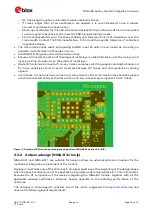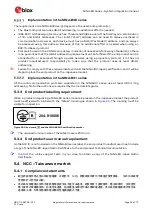
NINA-B3 series - System integration manual
UBX-17056748 - R13
Regulatory information and requirements
Page 47 of 72
C1-Public
5
Regulatory information and requirements
NINA-B3 series modules are certified for use in different regions and countries such as Europe, USA
and Canada. See the NINA-B3 series data sheet
for a list of approved countries/regions where
NINA-B3 modules are approved for use. Each market has its own regulatory requirements that must
be fulfilled, and the NINA-B3 series modules comply with the requirements for a radio transmitter in
each of the listed markets.
In some cases, limitations must be placed on the end product that integrates a
NINA-B3 module to comply with the regulatory requirements. This chapter lists the limitations and
requirements that a module integrator must take into consideration. It is divided into different
subsections for each market.
at the end of this chapter provides a summary of the requirements for
each market.
⚠
This section reflects u-blox
’ interpretation of different regulatory requirements of a radio device
in each country/region. It does not cover all the requirements placed on an end product that uses
the radio module of u-blox or any other manufacturer.
5.1
ETSI
–
European market
5.1.1
Compliance statement
Detailed information about European Union regulatory compliance for the NINA-B3 series modules is
available in the NINA-B3 Declaration of Conformity
⚠
Module integrators are required to make their own “Declaration of Conformity”, in which test
standards and directives that are tested and fulfilled by the end product are listed.
5.1.2
NINA-B3 Software security considerations
⚠
An end user cannot be allowed to change the software on the NINA-B3 module to any unauthorized
software or modify the existing software in an unauthorized way. A module integrator must
consider this in the end product design. Typically, the SWD interface (the
SWDCLK
and
SWDIO
pins) must not be accessible by the end user.
5.1.3
Output power limitation
The Radio Equipment Directive requires radio transmitters that have an Effective Isotropic Radiated
Power (EIRP) of 10 dBm or more, to either implement an adaptivity feature or reduce its medium
utilization.
NINA-B3 series modules are based on the Nordic Semiconductor nRF52840 chip, which supports
multiple radio protocols such as Bluetooth low energy, IEEE 802.15.4 with thread, etc.
Since Bluetooth low energy does not support either adaptivity or reduced medium utilization, a
NINA-B3 Bluetooth LE implementation on the European market must have an EIRP of less than 10
dBm.
⚠
In the European market, it is the end product manufacturer that holds the responsibility that
these limitations are followed. If the u-blox module integrator is not the end product manufacturer,
the module integrator should make sure that this information is shared with the end product
manufacturer.
☞
Radio protocols based on 802.15.4, which supports adaptivity is allowed an EIRP of 10 dBm or
higher.
















































